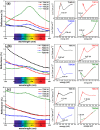Analysis of the Photocatalytic Activity and Adsorption of CuS Nanoparticles Synthesized by Chemical Route for the Degradation of Organic Contaminants
- PMID: 40727768
- PMCID: PMC12290959
- DOI: 10.1021/acsomega.5c02366
Analysis of the Photocatalytic Activity and Adsorption of CuS Nanoparticles Synthesized by Chemical Route for the Degradation of Organic Contaminants
Abstract
The treatment of industrial and domestic wastewater is an urgent environmental need. In this context, the photocatalytic activity of semiconductors offers a promising route for degrading organic contaminants. CuS nanoparticles were chemically synthesized using thiourea and copper sulfate in varying concentrations to investigate how precursor ratios affect the chemical composition, structural and morphological features, and optical-electronic properties. The photocatalytic degradation of methylene blue under low-power visible light (10 W), without H2O2 and using a low catalyst dose, showed promising results. Samples with lower sulfate content reached ∼78% degradation, while those with 0.20 M thiourea and 0.15-0.20 M sulfate achieved up to 99%. Mesoporous and macroporous structures (3.85-50 nm) promoted adsorption without hindering photocatalytic efficiency, indicating that, in certain samples, the combined morphological and electronic features enhanced dye removal.
© 2025 The Authors. Published by American Chemical Society.
Figures
















Similar articles
-
Synergistic effect of Co3O4/CdAl2O4 nanocomposite for photocatalytic decontamination of organic dyes under visible light irradiation.Sci Rep. 2025 Jul 2;15(1):22454. doi: 10.1038/s41598-025-07095-2. Sci Rep. 2025. PMID: 40596534 Free PMC article.
-
Impacts of r-GO and N-doping on the structural, magnetic, optical and photocatalytic properties of CuAl2O4: enhanced crystal violet removal under solar light irradiation.RSC Adv. 2025 Jul 10;15(30):24223-24235. doi: 10.1039/d5ra02304a. eCollection 2025 Jul 10. RSC Adv. 2025. PMID: 40656586 Free PMC article.
-
Oxygen vacancies mediated enhanced photocatalytic activity of band gap engineered BaSn1-x Cu x O3 towards methylene blue degradation under visible and sunlight.RSC Adv. 2025 Jul 14;15(30):24802-24814. doi: 10.1039/d5ra02900g. eCollection 2025 Jul 10. RSC Adv. 2025. PMID: 40661199 Free PMC article.
-
The effectiveness and cost-effectiveness of carmustine implants and temozolomide for the treatment of newly diagnosed high-grade glioma: a systematic review and economic evaluation.Health Technol Assess. 2007 Nov;11(45):iii-iv, ix-221. doi: 10.3310/hta11450. Health Technol Assess. 2007. PMID: 17999840
-
Intravenous magnesium sulphate and sotalol for prevention of atrial fibrillation after coronary artery bypass surgery: a systematic review and economic evaluation.Health Technol Assess. 2008 Jun;12(28):iii-iv, ix-95. doi: 10.3310/hta12280. Health Technol Assess. 2008. PMID: 18547499
References
-
- Iqbal T., Jameel M. A., Farooq M., Mansha M. S., Afsheen S., Al-Zaqri N., El-marghany A., Warad I., Khan H.. Facile hydrothermal synthesis of Cu-doped MoS2 nanomaterial: a potential photocatalyst for degradation of MB dye. Opt. Quantum Electron. 2024;56:156. doi: 10.1007/s11082-023-05759-9. - DOI
-
- Qin, N. ; Wei, W. ; Huang, C. ; Mi, L. , An Efficient Strategy for the Fabrication of CuS as a Highly Excellent and Recyclable Photocatalyst for the Degradation of Organic Dyes, Catalysts 2020. 10 (2020) 40. 10.3390/catal10010040. - DOI
-
- Sarker B., Keya K. N., Mahir F. I., Nahiun K. M., Shahida S., Khan R. A.. Surface and Ground Water Pollution: Causes and Effects of Urbanization and Industrialization in South Asia. Sci. Rev. 2021;7:32–41. doi: 10.32861/sr.73.32.41. - DOI
-
- Isac L., Cazan C., Andronic L., Enesca A.. CuS-Based Nanostructures as Catalysts for Organic Pollutants Photodegradation. Catalysts. 2022;12:1135. doi: 10.3390/catal12101135. - DOI
-
- Mousavi-Kamazani M., Zarghami Z., Salavati-Niasari M.. Facile and Novel Chemical Synthesis, Characterization, and Formation Mechanism of Copper Sulfide (Cu2S, Cu2S/CuS, CuS) Nanostructures for Increasing the Efficiency of Solar Cells. J. Phys. Chem. C. 2016;120:2096–2108. doi: 10.1021/acs.jpcc.5b11566. - DOI
LinkOut - more resources
Full Text Sources
